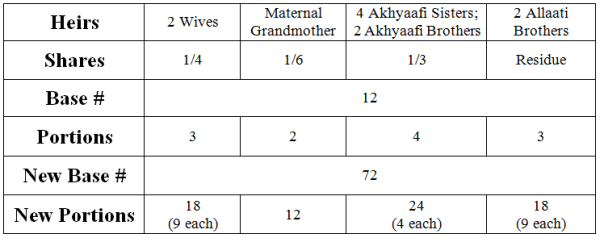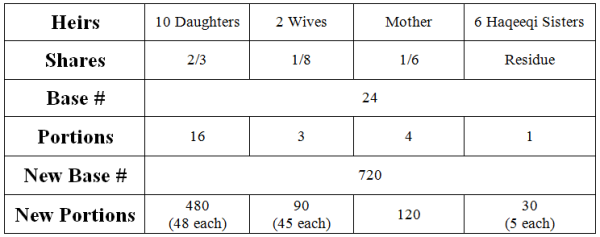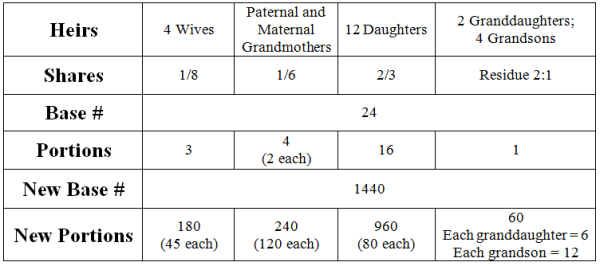Adjusting the Base Number When Heirs of Three or More Categories Cannot Share Portions Evenly
The following is the answer to the problem which was presented at the end of the previous post:
The estate will be divided into 16 equal portions:
Each Wife gets 1 portion.
Each Allaati brother gets 4 portions.
Each Allaati sister gets 2 portions.
Any questions readers may have about the answer and how it was reached should be posted in the comments section, insha’Allah.
So far we’ve learned how to deal with scenarios in which heirs of a single category and heirs of two categories cannot share their portions evenly, i.e. in whole numbers. In this post we will learn how to deal with scenarios in which heirs of three or more categories cannot share their portions evenly. We say ‘three or more’ because what you’ll learn in this post applies also to four categories, and five, and six, and so on. However, three categories is about as deep as it gets. You most likely will never have to deal with a scenario in which more than three categories need to be resolved.
The rule here is simple and involves everything we’ve learned in the previous two posts. We first pick any two out of the three problematic categories and resolve them (i.e. determine if they are tabayun/tawafuq, apply the necessary rules, etc.). We ignore the third category for now and work on resolving only the two categories just like we learned in the previous post, except this time you do not multiply by the current base number at the end. Stop immediately before that, and whatever number you have (i.e. whatever number you would have multiplied by the base number) will be called X. Next we resolve the remaining category on its own. If the heads-portions of the category are tabayun, then the number of heads is Y. If the heads-portions are tawafuq, then the wafq of the number of heads is Y. Now we resolve X and Y using one of the 4 sub-set rules we learned in the previous post, and our end result will be the new base number.
In summary, we first find X using any two problematic categories and the rules in the previous post (resolving two categories). We then find Y by using the remaining problematic category. Finally, we resolve X and Y using one of the 4 sub-set rules learned in the previous post. The end result will be our new base number.
Lets work out some examples insha’Allah.
Example 1: A man dies leaving behind
- Maternal grandmother
- 2 Wives
- 4 Akhyaafi sisters
- 2 Akhyaafi brothers
- 2 Allaati brothers
In this case, everyone inherits.
The initial chart looks like this:
All categories are problematic (i.e. portions are unable to be shared evenly) except for the maternal grandmother category. As per the rules, we first resolve two categories. These can be any two categories out of the three problematic ones. In this example, we chose to first resolve the wives category and the allaati brothers category.
Lets apply the rules we learned in the previous post for resolving two categories. The heads and portions of both categories are tabayun. Following the rules for resolving two categories, we realize we are dealing with the first possibility listed, and need to consider the heads of each category. In this case, both categories have 2 heads, making them tamathul. If there were no more categories to resolve, we would simply multiply 2 by the current base number (applying sub-set rule #2) and that would give us our new base number. But as previously explained, since we have another category to resolve, we do not multiply by the base number just yet. Rather we keep the 2 and call it X.
The remaining problematic category is the akhyaafi siblings category. This category’s heads-portions are 6 and 4, respectively, making them tawafuq with a GCF (Greatest Common Factor) of 2. We learned that when the heads and portions the category are tawafuq (as they are in this case) we find the wafq of the number of the heads and that will be our Y. In this case, the wafq of the number of heads is 3 (6 ÷ 2 = 3). Thus, Y = 3.
Now that we have both X and Y (2 and 3, respectively), we resolve them using the appropriate of the four sub-set rules listed in the previous post. In this case, 2 and 3 are tabayun, hence we apply the first sub-set rule and multiply them to get 6. Following this sub-set rule to the end, we then multiply the result by the current base number to get our new base number. In this case, we multiply 6 by 12 to get 72. This is now our new base number
Now that we have an updated base number, our new chart looks like this:
As you can see, all categories have now been resolved and their individual heirs can share the portions in whole numbers.
Final Answer: The estate will be divided into 72 equal portions:
Each Wife will get 9 portions.
The Maternal grandmother will get 12 portions.
Each Akhyaafi sibling will get 4 portions.
Each Allaati brother will get 9 portions.
Example 2: A man dies leaving behind
- 10 Daughters
- 2 Granddaughters
- 2 Wives
- Mother
- Paternal grandmother
- Maternal grandfather
- 6 Haqeeqi sisters
- 3 Allaati sisters
- 2 Akhyaafi paternal uncles
Maternal grandfather and akhyaafi paternal uncles are non-heirs. The 2 granddaughters, 3 allaati sisters and paternal grandmother are excluded. This leaves us with the following list of heirs:
- 10 Daughters
- 2 Wives
- Mother
- 6 Haqeeqi sisters
Which gives us the following initial chart:
Note that only the mothers category is non-problematic. The heirs of all the other categories cannot share their portions in whole numbers. Of course, now we do the same thing here as in example 1 to get our new base number.
As already explained, you can pair up any two categories and the final answer will be the same. In this case, we decided to first resolve the daughters and sisters category. Remember, the resolution of these two categories will give us X.
The heads-portions of the daughters category are tawafuq while the heads-portions of the sisters category are tabayun. We know now that we are dealing with the third possibility in the rules for resolving two categories. As per the rules, we consider the wafq of the number of heads of the tawafuq category and the heads of the tabayun category.
10 and 16 have a GCF of 2. The wafq of 10 (the number of heads) is thus 5.
The other category has 6 heads.
5 and 6 are tabayun, and so we multiply them to get 30. However, we do not multiply this by the base number. Rather this number is X.
The third and final problematic category has 2 heads and 3 portions; these two numbers are tabayun. Since the heads-portions are tabayun, we know that the number of heads (in this case, 2) is our Y.
X = 30|
Y =2
2 and 30 are tadakhul.
Remember, when resolving X and Y we use the appropriate sub-set rule. In this case, we use the third one, and thereby multiply the larger number (30) by the current base number. This will give us our new base number
30 x 24 = 720 <—- New base number.
The chart is now updated to what is seen below:
Final Answer: The estate will be divided into 720 equal portions:
Each Daughter gets 48 portions.
Each Wife gets 45 portions.
The Mother gets 120 portions.
Each Haqeeqi sister gets 5 portions.
Example 3: A man dies leaving behind
- 2 Granddaughters
- 4 Grandsons
- Paternal grandmother
- Maternal grandmother
- 12 Daughters
- 3 Haqeeqi brothers
- 4 wives
The haqeeqi brothers are excluded by the grandsons. Everyone else inherits.
We end up with the following chart:
All categories are problematic with the exception of the grandmothers’. Lets find our new base number.
We chose to first resolve the daughters and grandchildren categories.
The daughters category has 12 heads and 16 portions. These two numbers are tawafuq, with a GCF of 4.
The grandchildrens category has 10 heads and 1 portion. These two numbers are tabayun.
Now we know that we are dealing with the third possibility in the rules for resolving two categories. Therefore, we must multiply the wafq of the number of heads of the tawafuq category by the number of heads of the tabayun category.
12 ÷ 4 = 3 <—- wafq of 12
3 x 10 = 30 = X
The remaining category – the wives – has 4 heads and 3 portions. The heads-portions in this category are tabayun, thus Y = 4.
We now have to resolve X and Y.
30 and 4 are tawafuq (with a GCF of 2), which means we must apply the fourth sub-set rule to these numbers in order to end up with our new base number.
30 ÷ 2 = 15 ——-> 15 x 4 = 60
60 x 24 = 1440 <—– New base number.
New chart below:
Final Answer: The estate will be divided into 1440 equal portions:
Each Wife will get 45 portions.
The Paternal grandmother will get 120 portions.
The Maternal grandmother will get 120 portions.
Each Daughter will get 80 portions.
Each Granddaughter will get 6 portions.
Each Grandson will get 12 portions.
Insha’Allah, we hope this post was easy to understand. For further practice, we recommend that you re-do all examples on your own, but this time by pairing up different categories and resolving them in a different order. You should end up with the same final answer.
We end this post with a final exercise, the answer to which will be given in the next post, insha’Allah.
A man dies leaving behind:
- 2 Wives
- 5 Daughters
- 2 Granddaughters
- 3 Haqeeqi brothers
How will the estate be divided and distributed?






